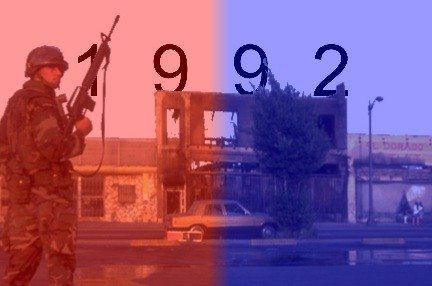Society
1992 Remembered: Driving Into the Wreck

It was a Wednesday night and my son was watching the news on TV in his room while I fixed dinner. “Dad,” he called from the bedroom, “Dad, you better get in here and see this.”
“This” turned out to be the beginnings of the worst urban social upheaval in American history. Its early moments were caught on film by a news helicopter high over the intersection of Florence and Normandie. We watched, transfixed, as some black kids pulled a white truck driver out of his cab and one of them hit him with a brick. An Asian woman was threatened as she tried to make a right turn off Normandie onto Florence, her face etched with fear. Car windows were broken. The news commentators called them “hoodlums” and the police were nowhere in sight. Then we watched as the city began to burn.
I was an undergrad at UC Santa Barbara when Watts upended L.A. in 1965, and now, in 1992, I wanted to see for myself what the aftermath of a night of riots looked like. So I put on my clerical collar – my defense against universal disorder – climbed in my old VW bug, and drove the streets of South L.A. I haphazardly drove to every United Methodist Church south of the I-10. From Vernon and Budlong to Normandie and 65th Street, to Grammercy near Manchester, over to 85th and Main, down past 103rd and Central, then back north toward the I-10.
The streets were relatively quiet in the morning-after hangover. Not many cars. Police units with officers crammed in, four-to-a-car, guns bristling. Latino families pushing shopping carts from looted supermarkets piled high with boxes of diapers, bottled water, canned food.
Every church I saw – including the ones I passed that weren’t Methodist, were locked up, closed. The ministers were home safe, apparently. Except for an older minister I knew at one place. He had spent the night at the church, he told me. He knew the gangs in the neighborhood and in the early morning hours he had pushed a flaming mattress away from a wall of the community center across the street that the church operated. Alone, he had talked down some kids in the neighborhood who were on a rampage.
Later up on West Adams, my long-time mentor, Rev. Jim Lawson, was also at his church, Holman United Methodist. He was the one who had invited Martin Luther King Jr. to Memphis to support the garbage workers’ strike and who had trained Nashville’s non-violent demonstrators. From his office window we now watched the smoke curling up from a dozen fires around the basin. We felt saddened by the events and the destruction, and we were aware of how much more there was to come before things turned around.
In 1965, the official response examined the needs in South L.A.: the bureaucracy of welfare, the neglect of schools, the absence of supermarkets, the segregated housing, the dearth of hospitals, the barest representation at City Hall, an occupying force of a nearly all-white police force. These were the results of a white Los Angeles that was not paying attention. As my then-bishop at the time said, “I didn’t know.”
In 1992 the response looked at the assets of South Los Angeles. Bankers took bus tours to places they had never seen and realized there were healthy loan opportunities there. Studies examined the amount of groceries people from the area purchased but could not buy in South Los Angeles, so firms promised to build supermarkets and strip malls. The school district geared up the largest municipal bond issue in American history to build new schools across the inner city. The media acknowledged and acclaimed the richness and diversity of cultural experience throughout the area. The city identified 52,000 jobs in South L.A. — where conventional wisdom said there were none — and initiated job creation and work-readiness projects.
In 1965 Los Angeles looked at the neglected needs of South Los Angeles. In 1992 it focused on asset analysis and the results attracted investments from both private and public sectors. The work is not done. Some of it has stalled, but in the aftermath of that upheaval the tone and the tenor shifted – and even the results – from despair to possibility. Those were changes my son and I would never have imagined as we sat in his room that night watching TV as L.A. burned.

-

 Latest NewsDecember 8, 2025
Latest NewsDecember 8, 2025This L.A. Museum Is Standing Up to Trump’s Whitewashing, Vowing to ‘Scrub Nothing’
-

 Striking BackDecember 4, 2025
Striking BackDecember 4, 2025Home Care Workers Are Losing Minimum Wage Protections — and Fighting Back
-

 Dirty MoneyDecember 3, 2025
Dirty MoneyDecember 3, 2025Trump’s Anti-Climate Policies Are Driving Up Insurance Costs for Homeowners, Say Experts
-

 Child FarmworkersDecember 5, 2025
Child FarmworkersDecember 5, 2025To Protect Underage Farmworkers, California Expands Oversight of Field Conditions
-

 Column - State of InequalityDecember 4, 2025
Column - State of InequalityDecember 4, 2025Can California Claw Back Some Medi-Cal Care?
-

 Latest NewsDecember 10, 2025
Latest NewsDecember 10, 2025Capital & Main, L.A. Times Win Sidney Award for Reporting on Child Farmworkers
-

 StrandedDecember 9, 2025
StrandedDecember 9, 2025Giving Up on the Dream: Asylum Seekers Try Other Options in Mexico
-

 Locked OutDecember 16, 2025
Locked OutDecember 16, 2025This Big L.A. Landlord Turned Away People Seeking Section 8 Housing

